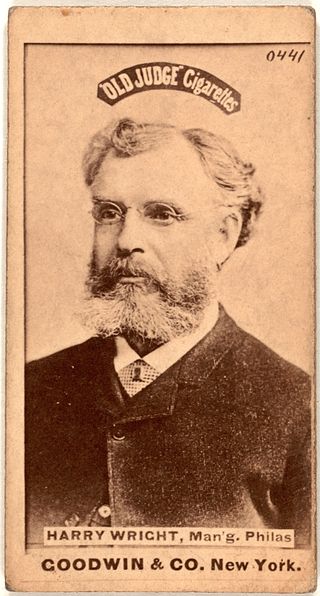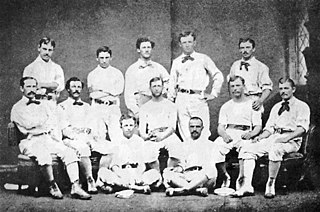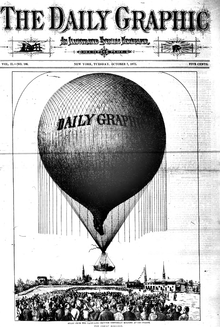
Joseph Start, nicknamed "Old Reliable", was one of the most durable regulars of baseball's earliest era, and one of the top first basemen of his time. He began his playing career in 1859, before the formation of organized leagues and before ballplayers received payment for their services. He continued to play regularly until 1886, when he was 43. Start's career spanned countless innovations that transformed the game in fundamental ways, but he adjusted and continued to play at a high level for almost three decades. Baseball historian Bill Ryczek said that Start "was the last of the pre–Civil War players to hang up his cleats."
The National Association of Professional Base Ball Players (NAPBBP), often known simply as the National Association (NA), was the first fully-professional sports league in baseball. The NA was founded in 1871 and continued through the 1875 season. It succeeded and incorporated several professional clubs from the previous National Association of Base Ball Players (NABBP) of 1857–1870, sometimes called "the amateur Association". In turn, several NA clubs created the succeeding National League of Professional Baseball Clubs, which joined with the American League of Professional Base Ball Clubs to form Major League Baseball (MLB) in 1903.
The Cincinnati Red Stockings of 1869 were baseball's first all-professional team, with ten salaried players. The Cincinnati Base Ball Club formed in 1866 and fielded competitive teams in the National Association of Base Ball Players (NABBP) 1867–1870, a time of a transition that ambitious Cincinnati businessmen and English-born ballplayer Harry Wright shaped as much as anyone. Major League Baseball recognized those events officially by sponsoring a centennial of professional baseball in 1969.

William Henry "Harry" Wright was an English-born professional baseball player, manager, and developer. He assembled, managed, and played center field for baseball's first fully professional team, the 1869 Cincinnati Red Stockings. He is credited with introducing innovations such as backing up infield plays from the outfield and shifting defensive alignments based on hitters' tendencies. For his contributions as a manager and developer of the game, he was inducted into the Baseball Hall of Fame in 1953 by the Veterans Committee. Wright was also the first to make baseball into a business by paying his players up to seven times the pay of the average working man.
Union Grounds was a baseball park located in the Williamsburg section of Brooklyn, New York. The grounds opened in 1862, its inaugural match being played on May 15. It was the first baseball park enclosed entirely by a fence, thereby allowing proprietor William Cammeyer or his tenant to charge admission. This permitted paying customers to watch the games from benches in a stand while non-paying spectators could only watch from embankments outside the grounds.

The Athletic Base Ball Club of Philadelphia was a prominent National Association, and later National League, professional baseball team that played in the second half of the 19th century.

The Atlantic Base Ball Club of Brooklyn was baseball's first champion and its first dynasty. The team was also the first baseball club to visit the White House in 1865 at the invitation of President Andrew Johnson.
The National Association of Base Ball Players (NABBP) was the first organization governing American baseball.

The Elysian Fields in Hoboken, New Jersey, was recreational parkland located on the city's northern riverfront in the 19th century. The area was a popular getaway destination for New Yorkers in the 19th century, much in the tradition of the pleasure garden, offering open space for a variety of sports, public spectacles, and amusements. The lavish grounds hosted the Colonnade Hotel and tavern, and offered picnic areas, a spa known as Sybil's Cave, river walks, nature paths, fishing, a miniature railroad, rides and races, and a ferry landing, which also served as a launch for boating competitions.
The following are the baseball events of the year 1869 throughout the world.

Eckford of Brooklyn, or simply Eckford, was an American baseball club from 1855 to 1872. When the Union Grounds opened on May 15, 1862 for baseball in Williamsburg, Brooklyn, it became the first enclosed baseball grounds in America. Three clubs called the field on the corner of Marcy Avenue and Rutledge Street home; however, the Eckford of Brooklyn were the most famous tenant. They played more games than any other club that year (7) and won the "national" championship, repeating the feat in 1863. During that two year period, the Eckfords won 22 straight matches which was the longest undefeated and untied streak to date. In the late 1860s, they were one of the pioneering professional clubs, although probably second to Mutual of New York at the home park. In its final season, Eckford entered the second championship of the National Association, the first professional baseball league in America, so it is considered a major league club by those who count the NA as a major league.
The Middletown Mansfields were an early baseball team in Middletown, Connecticut that existed from 1866 to 1872.

Dexter Park was a horse race track in Chicago built in the years following the Civil War. It was named for a gelding and trotter who had set world records for the mile and inspired the naming of several new towns including Dexter, Missouri, and Dexter, Texas. The track's formal opening was held in July 1867.

Fredrick Elroy Goldsmith was a right-handed pitcher in 19th-century professional baseball in both the U.S. and Canada. In his prime, Goldsmith was six-foot-one-inch tall and weighed 195 pounds.
The Washington Nationals of the 1870s were the first important baseball club in the capital city of the United States. They competed briefly in the National Association of Professional Base Ball Players, the first fully-professional sports league in baseball. The Nationals are considered a major-league team by those who count the National Association as a major league. Several other baseball clubs based in Washington, D.C., have also used the historic name Nationals.

Andrew Jackson Leonard was an Irish born professional baseball player of the 19th century, who played outfield and was also a utility infielder. He played left field for the original Cincinnati Red Stockings, the first fully professional baseball team. He was one of five men to play regularly for both the Cincinnati and the Boston Red Stockings, the latter winning six championships during his seven seasons. He played several infield positions on lesser teams in his early twenties but left field was his regular professional position.
The Lincoln Park Grounds, commonly known as Union Grounds, was a former baseball park, part of Lincoln Park, located in Cincinnati, Ohio. The Grounds were built for the Union Cricket Club in 1856; they "were used for cricket and baseball in the summer and were flooded for skating in the winter." In 1865 Harry Wright became the professional of the Cincinnati Cricket Club, which also used the grounds, and the next year Aaron Champion, president of the new Cincinnati Base Ball Club, "approached Wright to propose a limited use of the grounds if the CBBC and Live Oaks club would put in $2000 each to revamp the Lincoln Park Grounds."
A year later the [Red Stockings] leased the grounds of the Union Cricket Club for its home tilts. Most club members referred to the field as the Union Grounds, although it also was known as the Union Cricket Club Grounds and the Lincoln Park Grounds, given the fact that the eight-acre, fenced grounds were located in a small park behind Lincoln Park in Cincinnati, near the Union Terminal. It was a twenty-minute ride by streetcar to the Union Grounds from the heart of downtown Cincinnati. Aaron Champion ordered that approximately $10,000 worth of improvements be made to the home grounds for the 1867 season, including grading and sodding of the field and building of a new clubhouse and stands.
The Enterprise Base Ball Club of Brooklyn was an American baseball club in the 1850s and 1860s.

















